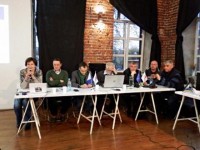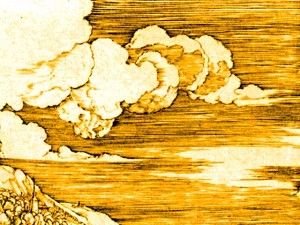The Belarusan National Platform of the EaP CSF issued a statement in connection with the wave of searches in the editorial offices of the Belarusan media and the detention of journalists.
Michal Aniempadystau: In the current situation Intermarum is a totally politically unrealistic project

How Belarus can use the idea of a new unified Europe?
Recently, we have been feeling interest to the Ukrainian, Polish culture; and there is interest on their part, too, because we have similarities and a common cultural heritage — The Great Duchy of Lithuania and the Polish—Lithuanian Commonwealth, believes cultural persona, designer and poet Michal Aniempadystau.
EuroBelarus Information Service cites the thinker’s thoughts regarding Intermarum region and our possible role in it.
The idea of the Intermarum is based on our geographical position. We are situated at a watershed, our rivers fall into the Baltic and the Black Seas; thus, their basins unite in our territory.
The formations, which combined these basins, started to emerge as early as prehistoric times, and the first one that was recorded was the so-called “Amber Road” from East Prussia to the Roman Empire. The main artery of this path was river Vistula. Another formation is the path “from the Vikings to the Greeks.” Later “intermarium” formations were the Grand Duchy of Lithuania, which was also as big as “from sea to sea,” the Polish-Lithuanian Commonwealth, which not only combines two marine basins, but also two different state entities.
“The interest to this idea isn’t decreasing; on the contrary, it’s growing, as evidenced by Andrzej Duda’s statements on the intention to get back to the idea of Intermarum,” Michal Aniempadystau said.
The idea of creating a Baltic-Black Sea region is not new. The idea of the unity of Poland, Lithuania (Belarus) and Rus’ (Ukraine) goes back to the days of Union of Krewo (1385) and then is strengthened by Union of Horodło (1413), Union of Lublin (1569), Treaty of Hadiach (1658), Convent Polonia studentenverbindung in 1828. The last three formations include the ancestors of the Belarusians, so we can say that it was on the territory of Lithuania-Belarus where the most intense idea of Intermarium was formed.
In 1832-1861 years Intermarium existed in the form of the so-called Adam Jerzy Czartoryski plan. But, according to Michal Aniempadystau, it was quite cunning: Lithuania and Rus’ weren’t mentioned in it, but were all included in Poland. However, Czartoryski’s plan collapsed in 1861 due to the lack of funding. But the idea of Intermarium has not disappeared.
Towards the end of the 19th century this idea faded into the background, while political and social struggle made a step forward. The situation changed with the 1905 revolution, where the fight for national liberation was growing. In 1904, the Englishman Halford Mackinder formulated the Heartland Theory, which says that a huge part of the Eurasian mainland has no outlet to the Baltic and Black Seas basins. According to Mackinder, the only way to Russia goes from Europe through Eastern Europe.
“This Heartland is imposed on the current Russian Eurasianism, in result of which the EAEU was formed,” Michal Aniempadystau notes. “The victory of Eurasianism happened, and it is important that Belarus is involved in it. After all, all these political projects don’t work without Belarus.”
Jozef Pilsudski consistently tried to realize the idea of the Intermarum. He believed that such a confederation would help to avoid the domination of Germany and Russia. And even before him in 1916 Anton Lutskevich, the Belarusian national revival activist who dreamed to create something like the United States, suggested a similar model of the Baltic-Black Sea community.
However, Soviet Russia took no interest in the implementation of the Intermarum. Gradually, Ukraine and Belarus took the same position, Lithuania was and is very cautious about this geopolitical project; thus, the idea has marginalized. After the collapse of the Soviet Union the idea of Intermarum started to arise again, but never went further than talks.
“For me, in the current situation Intermarum is a totally politically unrealistic project and even if we considered it than only in a cultural and ecological perspective,” Michal Aniempadystau says.
He believes that Belarus could be the initiator of cultural trends.
“Why do we need it? To have our brand and to “sell” ourselves in the wide sense,” summed up the designer.
Others
-
Statement of the Belarusan EaP CSF National Platform on solidarity with the civil society of Armenia
The Belarusan National Platform of the Eastern Partnership Civil Society Forum issued a statement on solidarity with the civil society of Armenia.
-
Statement of the BNP in connection with the criminal prosecution of the leaders of the Belarusan independent trade unions
The Belarusan National Platform of the Eastern Partnership Civil Society Forum issued a statement in connection with the criminal prosecution of the leaders of the Belarusan independent trade unions.
-
Final event of project CHOICE — Paving the way to European Year of Cultural Heritage 2018
The final event of the two-year EU funded project CHOICE — Cultural Heritage: Opportunity for Improving Civic Engagement was held on June 6, 2017 at the Committee of the Regions, in Brussels.
-
Heritage is a verb. The results of the CHOICE project were summarized in Minsk (Photos and video)
Does Belarus need a “Public Ministry of Culture” and “Ašmiany Charter” to deal with the historical and cultural sites?








Comments
From farewell to a new Eastern policy and towards a new development
Poland and Germany were both initiators and drivers of a New Eastern policy linked to the Eastern neighborhood and Russia/Soviet Union.